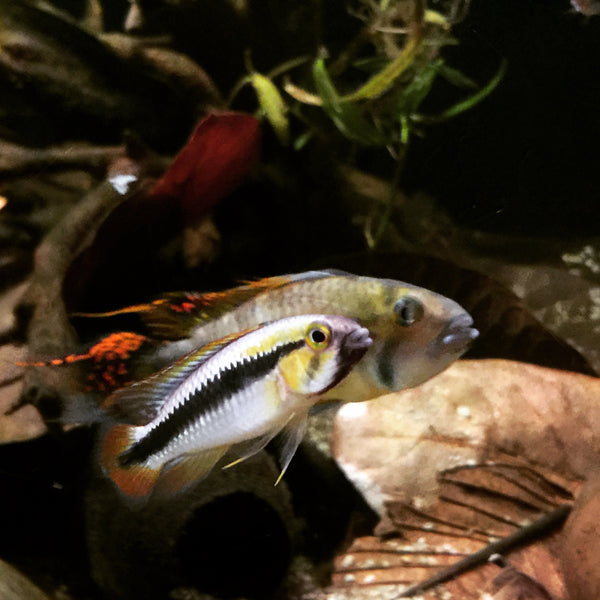- Continue Shopping
- Your Cart is Empty
A lot of barking about...bark!
People often ask me to pick them more "unusual" or "scarce" stuff for their Enigma packs, or to recommend botanicals that are not always used widely...and I don't need to think to hard on it, either! I reach for Catappa bark!
So... you see me talking about Catappa bark all over our website, and on social media, and by now, you have probably reached one of the following conclusions:
1) Fellman is slightly crazy (not too far off the mark, I might add…)
2) Catappa bark has some intriguing features (bingo!)
3) Fellman is slightly crazy (I think I’ve heard this before…)
Okay, let’s focus on #2…Catappa bark is a really amazing product, with lots of cool uses around the aquarium. It's been used by fish geeks for many years, but has always sort of been "lost in the shadow" of its more popular cousin, the Catappa leaf.
We’ll start with explaining what this stuff is. It comes from the Indian Almond Tree (Terminalia catappa). This tree provides many gifts for aquarists, including its wonderful bark. Like the leaves, Catappa bark offers a rich source of tannins, humic acids, and other substances which are thought to provide antibacterial and antifungal properties and other health benefits for aquarium inhabitants. It will, of course, impart a lovely shade of brown into the water- what we know as "The Tint" around here!

It’s a very cool-looking material, too. It accurately replicates the fallen branches and woods that accumulate on the bottom of tropical streams and rivers, enriching the substrate and surrounding waters with the aforementioned tannins. Although the bark sections are not “branchy” in the true sense, they do have a very distinctive appearance that will add to the interest of your aquascape. I've always been surprised that we don't see more of them used in 'scapes.
They're available in two forms: "Strips", which are just that- little strips of bark, and "logs", which are rooted and toed sections of bark. Heftier, more substantial, and pricier than strips, they do offer more aquascaping potential. The strips are more "utilitarian" than aesthetic, but they do look kind of cool scattered about in the substrate! Both impart a lot of tannins into the water and last a good long time!
So why don't we see more of them?
Well, I think part of the problem is that this stuff IS kind of pricy. I admit it. Most of it is harvested, rolled, and cut by hand, so it's labor intensive and costs us a lot to begin with. We don't get it in enormous quantities However, it's really interesting stuff and should be used more...and perhaps if more and more hobbyists use it, we can bring in more and hopefully employ economies of scale to bring costs down!
Fish breeders (particularly Betta and Discus breeders) worldwide use pieces of the bark to provide the benefits of tannins to their fishes in breeding and show setups. Religious users of Catappa products in general will tell you that they regularly achieve more frequent spawns, better colors in their fishes, and higher egg viability rates in waters which contain Catappa. And with logs or bark strips lasting longer than catappa leaves, it might be a nice alternative, right?

Another great benefit of Catappa bark is that it offers a place for smaller fishes, as well as larval fishes, to hide. In addition, it can be utilized as a spawning substrate for various species of small cichlids, such as the much-loved (around here!) Apistogramma.
I'd like to see some killie and rainbow fish hobbyists experiment with them as spawning substrates, too! Top spawning killies (like Epiplatys, RIvulus, Aphysemion, etc.)could utilize them as a spawning substrate in even "bare" breeding tanks, deriving not only the benefits of the tannins and humic substances, but having a secure spot to deposit their eggs on that is easily harvested by the breeder! Hmm...

If you keep ornamental shrimp, you’ll love this stuff as much as the shrimp will, because it provides a beneficial “foraging area” for them, as they graze on the biofilm that inevitably accumulates on the submerged bark sections, as well as on the softening bark itself. Plecostomus and other Loricarid catfishes will be seen scraping this bark for supplemental nutrition, which, in turn, further releases the valuable tannins and other substances into the water column.

When we first started Tannin, it was a forgone conclusion that we’d carry Catappa bark. What wasn’t easy, however, was to secure a reliable, sustainably-minded source. We took quite some time, tried a few different outfits, and vetted a number before finding our supplier, from a small, family-owned business in a village in India. I came to know the young owner of the business quite well, and knew that he had his head and heart in the right place, so choosing to do business with him was a proverbial “no-brainer.”

Catappa bark sections are good stuff! They are carefully cleaned, dried, and some are rolled and tied into attractive little "logs", with tons of character! Others retain their natural form. They're all beautifully random and imperfect! We try to give you a little variety in each pack... We find this "randomness" quite charming....
Regardless of whether or not you choose to use this bark for aquascaping, its water-conditioning properties, supplemental nutrition for fishes and shrimp, a spawning substrate- or all of the above- this stuff is one of the “core products” that any “bontanically-oriented” aquarium hobbyist should utilize in their systems!
Think about it!
Stay creative. Stay curious. Stay motivated.
And Stay Wet.
Scott Fellman
Tannin Aquatics









Scott Fellman
Author